WR 104 is a young star system consisting of three exceptionally hot stars, a Wolf-Rayet star and two luminous blue main sequence stars. The system lies about 8,400 light years from Earth in the constellation Sagittarius. With an apparent magnitude of 13.28, it is invisible to the unaided eye.
The Wolf-Rayet component is popularly known as the Pinwheel Star. It is surrounded by a spiral Wolf-Rayet nebula, often called a pinwheel nebula. The nebula is believed to be the product of colliding winds in the close binary system.
The Wolf-Rayet star is expected to end its life as a supernova in the next few hundred thousand years. When it does, there is a slight chance that it may produce a gamma-ray burst (GRB) approximately in the direction of Earth. The rotational axis of the star system may be directed towards our planet. However, in 2025, astronomers reduced the potential threat, suggesting that the system’s orbit is much more tilted than previously believed.
Star system
WR 104 is a triple star system composed of a close binary pair – a Wolf-Rayet star and a B-type main sequence star – and a more distant O-type star. All three stars are exceptionally hot and luminous. They have apparent magnitudes of 12.7, 14.6, and 15.36. The close binary star has a combined visual magnitude of 13.28.
The Wolf-Rayet star in the WR 104 system has the spectral type WC9d. The “C” indicates dominant lines of ionised carbon, while the suffix “d” indicates dust in the star’s spectrum.
Wolf-Rayet stars are rare stars with spectra that show broad emission lines of ionized helium and ionized nitrogen or carbon. They are highly enhanced in heavy elements, have an underabundance of hydrogen, and their surface temperatures can be as high as 210,000 K.
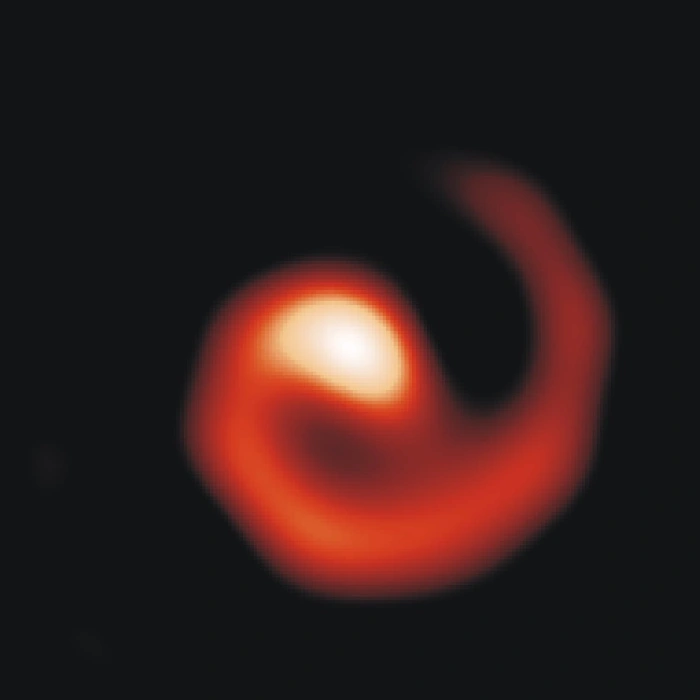
False-color infrared image of Wolf-Rayet star WR 104 taken at the W. M. Keck Observatory. Image credit: NASA, Keck Telescope (PD)
Like many other WR stars of the carbon sequence (WC), WR 104 is notable for its production of dust. Dust formation is typically seen in stars in binary systems and is a product of the collision of the fast winds of these massive stars. The high-velocity stellar winds drive off the stars’ outer atmospheres through proton pressure. The dust in the powerful winds makes the stars give off infrared emission.
WR 104 has a mass 10 times that of the Sun and a radius 3.29 times solar. It is 40,000 times more luminous than the Sun with an effective temperature of about 45,000 K.
The Wolf-Rayet stage is a very brief period in the evolution of the most massive stars before they go out as supernovae at the end of their lives. Some of these stars have spent a period as red supergiants, while the most massive ones have evolved into Wolf-Rayet stars directly from the main sequence.
The Wolf-Rayet star and the B-type star in the WR 104 system form a spectroscopic binary pair. The two individual components cannot be resolved even in the largest of telescopes because the physical distance between them is only about 2.34 astronomical units (Earth – Sun distances). At a distance of 8,400 light years, this corresponds to an angular separation of about 1 milliarcsecond. The stars take 241.5 days to complete an orbit.
The close companion of the WR star is a main sequence star of the spectral type B0.5V. It has a mass of about 20 solar masses and a radius 10 times that of the Sun. With a surface temperature of 30,000 K, it is 80,000 times more luminous than the Sun. It has an estimated age of 7 million years.
The Wolf-Rayet star is considered to be the primary component in the system. Even though it is 0.3 magnitudes fainter than its spectroscopic companion in the visible part of the spectrum, it dominates the system’s overall spectrum.
The third component is fainter, with a visual magnitude of 15.36. It is a hot blue star of the spectral type O8V-O5V. It lies almost an arcsecond away from the binary pair and is believed to be physically associated with it. The star was first detected with the Hubble Space Telescope (HST) in 1998.
Observations with the SPHERE and VISIR instruments on the Very Large Telescope (VLT) in 2018 confirmed that the star was a physical companion, gravitationally bound to the spectroscopic binary pair. The direct images of the system also confirmed the presence of the pinwheel structure around the stars. The study based on the SPHERE observations was published in Astronomy & Astrophysics, Volume 618, in October 2018. It was authored by an international team of astronomers at Côte d’Azur Observatory, the University of Genoa, the University of Lyon, the California Institute of Technology, the European Southern Observatory (ESO), the Max Planck Institute for Radio Astronomy, the Marseille Astrophysics Laboratory, the Paris Observatory, and Université Grenoble Alpes.
The more distant companion has a surface temperature of at least 33,000 K and a luminosity of 68,000 Suns. It has an estimated mass of 7.98 solar masses. Assuming a circular orbit, the companion would be separated by 2,480 ± 120 astronomical units (AU) from the main pair.
WR 104 exhibits irregular variations in brightness caused by eclipses and other events. The eclipses are not believed to be caused by the companion but by the formation of the dust plume from the material ejected by the Wolf-Rayet star in the system. They do not affect the companion. The Wolf-Rayet star exhibits an almost continuous string of eclipses, which are sometimes concurrent and have a range of depths.
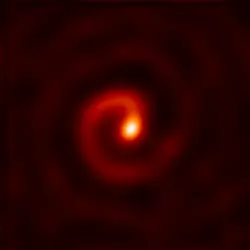
Animation of the Pinwheel Star (WR 104) based on observations with the Keck Telescope, credit: NASA, Keck Telescope (PD)
Supernova
Both components in the spectroscopic binary system are massive stars that are expected to meet their ends as core-collapse supernovae. The Wolf-Rayet star is expected to go out sooner, in the next few hundred thousand years.
There has been a lot of debate on whether the supernova will affect life on Earth, but there are too many uncertainties to make an accurate prediction.
The rotational axis of the binary pair – and probably of the two close companions – in the WR 104 system points roughly in the direction of our planet, at an inclination of 0 to 16 degrees. For this reason, WR 104 has been nicknamed the Death Star. However, the inclination may be greater. Spectroscopic observations with the Keck Telescope indicate that the system may be inclined 30° – 40° away from us.
The stars lie at too great a distance for the supernovae themselves to have a real impact on our planet’s biosphere. However, Wolf-Rayet stars with fast rotating cores are believed to produce long-duration gamma-ray bursts (LGRBs), which are emitted along their spin axes. If WR 104 does produce a LGRB, this could significantly affect Earth if it our planet lies within an opening angle of 12 degrees or less of the burst. Depending on the number of energetic particles and the amount of radiation, the Earth’s ozone layer and biosphere could suffer significant damage.
In 2015, Peter Tuthill of the University of Sydney suggested that this was an unlikely scenario because WR 104 lies at a great distance and our planet would have to be more directly in the way of the beam.
Both the Wolf-Rayet star and its close companion may produce a LGRB based on current models, but there are still too many unknown parameters to determine the likelihood of this outcome. To produce a LGRB, a star must be spinning very fast, and it is uncertain if this is the case with WR 104. There has been some evidence that suggests that Wolf-Rayet stars in the Milky Way may be slowed down too much to produce a gamma ray burst. These events have mostly been observed in low-metallicity galaxies, never in our own galaxy.
In 2024, a more recent study of the data collected at the Keck Observatory in Hawaii indicates that the stars’ orbits are tilted 30 to 40 degrees away from Earth. The conclusion presents a new mystery for astronomers to solve because of the misalignment between the spiral nebula, seen face-on, and the tilted orbit of the components. The study, led by astronomer Grant Hill of Keck Observatory, was published in the Monthly Notices of the Royal Astronomical Society. It is based on observations with the Low-Resolution Imaging Spectrometer (LRIS) on the Keck I telescope and the Echellette Spectrograph and Imager (ESI) and Near-Infrared Spectrograph (NIRSPEC) on the Keck II telescope on Maunakea, Hawaii, conducted from 2001 to 2023.
Pinwheel nebula
The Wolf-Rayet star in the WR 104 system is surrounded by a Wolf-Rayet nebula, an extended dust shell formed by the interaction of the stellar winds of the two stars in close orbit. In recent decades, WR 104 has often been referred to as the Pinwheel Star. Multiple observations have given the star the status of the prototype for a class of Wolf-Rayet stars that persistently produce dust and are surrounded by spiral plumes of dust.
Spiral in shape, the nebula is often called a pinwheel nebula. It has a diameter of more than 200 astronomical units. The nebula was imaged by the Keck Telescope in April 1998.
The nebula’s dust would not have formed near the WR star if the star were solitary due to its intense radiation. However, in the binary system it is formed when material in the region where the stars’ stellar winds collide is compressed. The spiral shape of the nebula is the result of the system’s natural orbital motion, which carries the dust around the system. It indicates that the system appears almost pole-on. The nebula’s outflow pattern has allowed astronomers to derive an orbital period of 241.5 ± 0.5 days for the two stars.
Facts
WR 104 was first identified as a binary system in 1977 by M. Cohen and L. V. Kuhi, who suggested that the companion was an early-type star. In 1987, Williams, van der Hucht and Thé estimated that the companion was 0.3 magnitudes brighter than the Wolf-Rayet star.
In 1999, Peter Tuthill, John Monnier and William Danchi of the Space Sciences Laboratory, University of California, found further evidence of a companion with an orbital period of 220 ± 30 days, based on interferometry with the Keck I telescope. The direct imaging of the dust flow showed that a binary star system was responsible for the creation of the dust spiral.
WR 104 was one of the first Wolf-Rayet stars discovered to show an infrared excess. An excess infrared emission typically indicates the presence of circumstellar dust. It was first reported by D. A. Allen, J. P. Swings and P. M. Harvey in 1972.
Name
The designation WR 104 comes from the names of the French astronomers Charles Wolf and Georges Rayet, who were the first to discover three stars in this class, now known as WR 134, WR 135 and WR 137, in 1867.
Wolf and Rayet used the 40 cm Foucault telescope at the Paris Observatory. Located in the northern constellation Cygnus, the three stars showed very broad emission lines that were originally believed to be hydrocarbon molecules, but are now associated with helium, nitrogen, carbon, silicon and oxygen, with weak or absent hydrogen lines.
The stars were called Wolf-Rayet stars from their discovery, but the naming convention for this class was not created until 1962, when the fourth catalogue of Wolf-Rayet stars in our galaxy was published and the stars were numbered in order of right ascension. Even though the numbering scheme used today is different and catalogues include new discoveries, the Wolf-Rayet stars in the Milky Way are still catalogued in this order.
Location
WR 104 lies just northwest of the Teapot asterism, in an area of the sky that is very familiar to stargazers because it contains several bright, large nebulae.
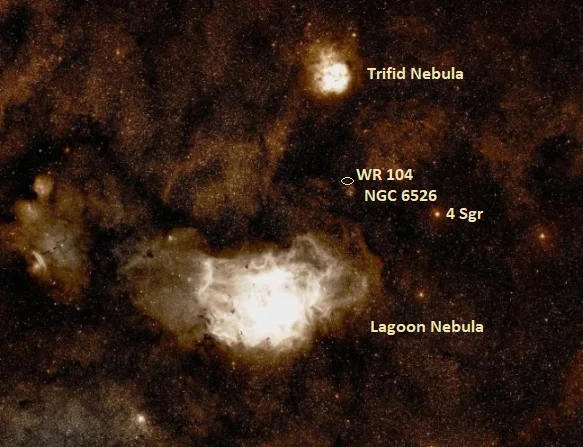
WR 104 location, image credit: ESO/Digitized Sky Survey 2 (CC BY 4.0)
The star is located between the Trifid Nebula (Messier 20) and the Lagoon Nebula (Messier 8), just north of the fainter emission nebula NGC 6526. With an apparent magnitude of 13.28, WR 104 is invisible to the unaided eye and cannot be seen in binoculars. It can only be seen in 6-inch and larger telescopes.
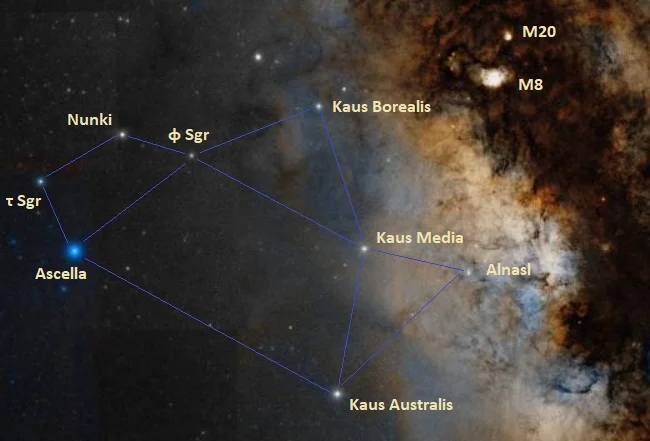
M8, M20 and the Teapot in Sagittarius, image credit: ESO/Digitized Sky Survey 2 (CC BY 4.0)
Constellation
WR 104 is located in the constellation Sagittarius. First catalogued by Claudius Ptolemy in his Almagest in the 2nd century CE, Sagittarius is considered to be one of the 48 Greek constellations. The celestial Archer stretches across 867 square degrees of the southern sky and is the 15th largest of all 88 constellations.
Easily recognizable for the Teapot pattern, the constellation is a popular target for backyard telescopes because it contains more Messier objects (bright deep sky objects catalogued by the French astronomer Charles Messier) than any other constellation.
In addition to the Trifid and Lagoon nebulae, these include the Omega (Swan) Nebula (Messier 17), the Small Sagittarius Star Cloud (Messier 24), the globular clusters Messier 22, Messier 28, Messier 54, Messier 55, Messier 69, and Messier 75, and the open clusters Messier 23 and Messier 25.
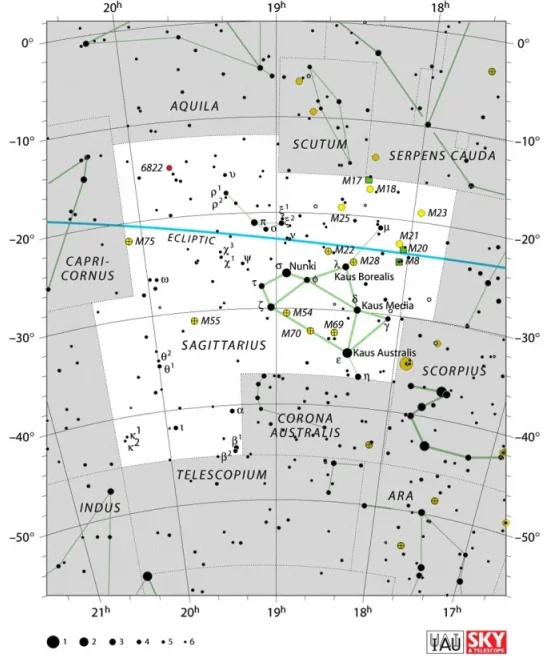
Sagittarius constellation map by IAU and Sky&Telescope magazine (Roger Sinnott & Rick Fienberg) (CC BY 3.0)
Other notable deep sky objects in Sagittarius include the planetary nebulae NGC 6537 (the Red Spider Nebula), NGC 6445 (the Box Nebula), NGC 6818 (the Little Gem Nebula), and M 1-42 (the Eye of Sauron Nebula), the star-forming nebula NGC 6559, Barnard’s Galaxy, and the Sagittarius Dwarf Elliptical Galaxy, one of Milky Way’s satellite galaxies. Sagittarius also contains Sagittarius A*, the Milky Way’s central black hole, and the massive open clusters known as the Quintuplet Cluster and the Arches Cluster near the Galactic centre.
The constellation’s brightest star, Kaus Australis (Epsilon Sagittarii), is a blue-white giant located approximately 143 light-years away. Other bright stars in the constellation include the hot blue main sequence star Nunki (Sigma Sagittarii), the A-type star Ascella (Zeta Sagittarii), the orange giants Kaus Media (Delta Sagittarii), Kaus Borealis (Kaus Borealis), Alnasl (Gamma2 Sagittarii) and Tau Sagittarii, the red giant Eta Sagittarii, and the white subgiant Albaldah (Pi Sagittarii).
Sagittarius also hosts the luminous blue variable known as the Pistol Star and the Wolf-Rayet star WR 102ka (the Peony Star), both among the most luminous stars known in our galaxy, the red supergiants KW Sagittarii and VX Sagittarii, notable for their exceptional size, and Sakurai’s Object (V4334 Sagittarii), a star believed to have been born again as a red giant after a brief period of being a white dwarf.
The best time of the year to observe the stars and deep sky objects of Sagittarius is during the month of August, when the constellation rises high above the horizon in the early evening. The entire constellation is visible from locations between the latitudes 55° N and 90° S.
The 10 brightest stars in Sagittarius are Kaus Australis (Epsilon Sgr, mag. 1.85), Nunki (Sigma Sgr, mag. 2.05), Ascella (Zeta Sgr, mag. 2.59), Kaus Media (Delta Sgr, mag. 2.70), Kaus Borealis (Lambda Sgr, mag. 2.82), Albaldah (Pi Sgr, mag. 2.89), Alnasl (Gamma² Sgr, mag. 2.98), Eta Sagittarii (mag. 3.11), Phi Sagittarii (mag. 3.17), and Tau Sagittarii (mag. 3.326).
WR 104
| Spectral class | WC9d + B0.5V + O8V–O5V |
| Apparent magnitude | 13.28 (12.7 + 14.6), 15.36 |
| Absolute magnitude | -5.4 (-4.8 + -4.6) |
| Distance | 8,415 ± 391 light years (2,580 ± 120 parsecs) |
| Parallax | 1.5644 ± 0.2004 mas |
| Proper motion | RA: -0.416 ± 0.255 mas/yr |
| Dec.: -0.339 ± 0.171 mas/yr | |
| Mass | 30 M☉ |
| Luminosity | 120,000 L☉ |
| Age | 7 million years |
| Constellation | Sagittarius |
| Right ascension | 18h 02m 04.1244400656s |
| Declination | −23° 37′ 42.168277056″ |
| Names and designations | WR 104, V5097 Sagittarii, V5097 Sgr, CSI-23-17590, IRAS 17590-2337, 2MASS J18020412-2337419, RAFGL 2048, IRC -20417, ASAS J180205-2337.7, JP11 5559, Ve 2-45, MR 80, MSX6C G006.4432-00.4858, UCAC2 22296214, Gaia DR2 4069167258796371712 |
WR
| Mass | 10 M☉ |
| Luminosity | 40,000 L☉ |
| Radius | 3.29 R☉ |
| Temperature | 45,000 K |
OB
| Mass | 20 M☉ |
| Luminosity | 80,000 L☉ |
| Radius | 10 R☉ |
| Temperature | 30,000 K |
B
| Luminosity | 68,000 L☉ |
| Radius | 7.98 R☉ |
| Temperature | ≥ 33,000 K |